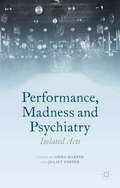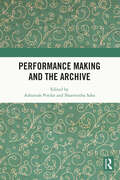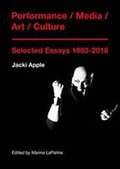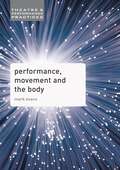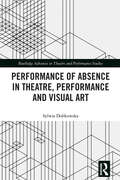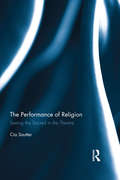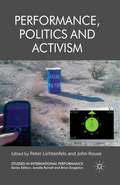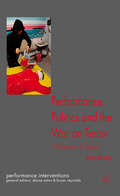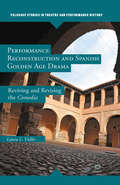- Table View
- List View
Performance Lighting Design: How to light for the stage, concerts and live events (Backstage)
by Nick Moran"Really does enable anyone from first year student to the established lighting designer to learn more and improve" Focus, the Journal of the Association of Lighting DesignersNew technologies have made lighting more prominent in live performances of all kinds, not just stage theatre, and in many courses lighting has been subsumed into `performance lighting'. Performance Lighting Design is a practical guide to the art and technique of lighting for the stage, concerts, and live events. The book will also cover the use of projected images in performance including projected scenery on the West End stage, in fringe shows, and on the stadium "rock" stage, as well as the use of images from live camera and from other sources as "performers". The book will serve students of lighting design and will also be accessible to anyone with an awareness of technical theatre. Practical knowledge is combined with aesthetic and theoretical considerations. The book will also address the difficult area of getting inspiration and evolving design ideas through a broad range of performance genre. The author will discuss the pros and cons of several computer based techniques, and incorporate 25 years of his own professional experience in the UK and Europe.
Performance, Madness and Psychiatry: Isolated Acts (Palgrave Politics of Identity and Citizenship Series)
by Anna Harpin Juliet FosterThis exciting collection of essays explores the complex area of madness and performance. The book spans from the 18th century to the present and unearths the overlooked history of theatre and performance in, and about, psychiatric asylums and hospitals. The book will appeal to historians, social scientists, theatre scholars, and artists alike.
Performance Making and the Archive
by Ashutosh Potdar Sharmistha SahaThis book investigates theories and practices shaped by a performance’s relationship to the archive. The contributions in the volume examine how the changing nature of performance practices has made it imperative to understand how the archive and archival practices could add to the performance work. They explore a variety of themes, including artistic engagement with the archive in both conceptual and material terms; physical, virtual and digital forms; publicly and privately collected; oral, written and digital ways; or organized and unorganized collections. Finally, the volume examines how archives are modelled on existing structure and the ways in which they can be brought into discourses and practices of performance making through engagement and contestation. A novel approach to performance theory, this volume will be of great interest to scholars and researchers of performance studies, media and culture studies, studies of technology and art as also literature and literary criticism.
Performance Making and the Archive
by Ashutosh Potdar Sharmistha SahaThis book investigates theories and practices shaped by a performance’s relationship to the archive. The contributions in the volume examine how the changing nature of performance practices has made it imperative to understand how the archive and archival practices could add to the performance work. They explore a variety of themes, including artistic engagement with the archive in both conceptual and material terms; physical, virtual and digital forms; publicly and privately collected; oral, written and digital ways; or organized and unorganized collections. Finally, the volume examines how archives are modelled on existing structure and the ways in which they can be brought into discourses and practices of performance making through engagement and contestation. A novel approach to performance theory, this volume will be of great interest to scholars and researchers of performance studies, media and culture studies, studies of technology and art as also literature and literary criticism.
Performance/media/art/culture (PDF): Selected Essays 1983-2018
by Jacki Apple Marina LaPalmaExperience the interdisciplinary performance scene of the 1980s and beyond through the eyes of one of its most compelling witnesses. Jacki Apple’s Performance / Media / Art / Culture traces performance art, multimedia theatre, audio arts, and dance in the United States from 1983 to the present
Performance, Medicine and the Human (Performance and Science: Interdisciplinary Dialogues)
by Alex MermikidesPerformance and medicine are now converging in unprecedented ways. London's theatres reveal an appetite for medical themes – John Boyega is subjected to medical experiments in Jack Thorne's Woycek, while Royal National Theatre produces a novel musical about cancer. At the same time, performance-makers seek to improve our health, using dance to increase mobility for those living with Parkinson's disease or performance magic as physiotherapy for children with paraplegia. Performance, Medicine and the Human surveys this emerging field, providing case studies based on the author's own experience of devising medical performances in collaboration with cancer patients, biomedical scientists and healthcare educators. Examining contemporary medical performance reveals an ancient preoccupation, evident in the practices of both theatre and healing, with the human. Like medicine, theatre puts the human on display in order to understand and, perhaps, alleviate the suffering inherent to the human condition. Medical practice constitutes a sort of theatre in which doctors, nurses and patients perform their humaneness and humanity. This insight has much to offer at a time when established notions of the human are being radically rethought, partly in response to emerging biomedical knowledge. Performance, Medicine and the Human argues that contemporary medical performance can shed new light on what it means to be human – and what we mean by the human, the humane, humanism and the humanities – at a time when these notions are being fundamentally rethought. Its insights are relevant to scholars in performance studies, the medical humanities, healthcare education and beyond.
Performance, Medicine and the Human (Performance and Science: Interdisciplinary Dialogues)
by Alex MermikidesPerformance and medicine are now converging in unprecedented ways. London's theatres reveal an appetite for medical themes – John Boyega is subjected to medical experiments in Jack Thorne's Woycek, while Royal National Theatre produces a novel musical about cancer. At the same time, performance-makers seek to improve our health, using dance to increase mobility for those living with Parkinson's disease or performance magic as physiotherapy for children with paraplegia. Performance, Medicine and the Human surveys this emerging field, providing case studies based on the author's own experience of devising medical performances in collaboration with cancer patients, biomedical scientists and healthcare educators. Examining contemporary medical performance reveals an ancient preoccupation, evident in the practices of both theatre and healing, with the human. Like medicine, theatre puts the human on display in order to understand and, perhaps, alleviate the suffering inherent to the human condition. Medical practice constitutes a sort of theatre in which doctors, nurses and patients perform their humaneness and humanity. This insight has much to offer at a time when established notions of the human are being radically rethought, partly in response to emerging biomedical knowledge. Performance, Medicine and the Human argues that contemporary medical performance can shed new light on what it means to be human – and what we mean by the human, the humane, humanism and the humanities – at a time when these notions are being fundamentally rethought. Its insights are relevant to scholars in performance studies, the medical humanities, healthcare education and beyond.
Performance Metrics for Sustainable Cities (Advances in Urban Sustainability)
by Sylvie Albert Manish PandeyPerformance Metrics for Sustainable Cities provides an overview of measurement systems and tools to enable communities to self-assess and benchmark their progress along a continuum of smart, intelligent, and sustainable development. It begins by explaining the importance of measurement and evaluation for cities and smaller communities, as well as future factors that will need to be considered and embedded into planning processes. Across 14 chapters, the book describes existing evaluation mechanisms that are being used for government funding decisions, awards of recognition, and new measurement systems to assess what makes a city smarter and more sustainable, such as broader sustainable goal targets (UN SDGs), green cities, fabrication cities, and compassionate cities. It presents examples of metrics used for important sustainability and liveability concepts for cities such as how to measure trust, engagement, compassion, circular economy, and so forth. The book ends with reflections on the feasibility of a holistic system of measurement and the implications of its implementation. This volume will be of great interest to students, researchers, and professionals of urban sustainability, planning, smart cities, and sustainable communities.
Performance Metrics for Sustainable Cities (Advances in Urban Sustainability)
by SylvieManish Albert PandeyPerformance Metrics for Sustainable Cities provides an overview of measurement systems and tools to enable communities to self-assess and benchmark their progress along a continuum of smart, intelligent, and sustainable development. It begins by explaining the importance of measurement and evaluation for cities and smaller communities, as well as future factors that will need to be considered and embedded into planning processes. Across 14 chapters, the book describes existing evaluation mechanisms that are being used for government funding decisions, awards of recognition, and new measurement systems to assess what makes a city smarter and more sustainable, such as broader sustainable goal targets (UN SDGs), green cities, fabrication cities, and compassionate cities. It presents examples of metrics used for important sustainability and liveability concepts for cities such as how to measure trust, engagement, compassion, circular economy, and so forth. The book ends with reflections on the feasibility of a holistic system of measurement and the implications of its implementation. This volume will be of great interest to students, researchers, and professionals of urban sustainability, planning, smart cities, and sustainable communities.
Performance, Movement and the Body (Theatre and Performance Practices)
by Mark EvansInvestigating a range of influential movement training practices, this ambitious book considers the significance of professional training to performers and their bodies. Performance training approaches are examined within their wider social and cultural contexts, illuminating their evolution in response to the changing context of theatre practice and production. Adopting a rigorous critical angle, Mark Evans' approach is at the cutting-edge of Theatre scholarship, drawing on interviews with recognised practitioners and considering the implications for movement and the body in the digital age.Engaging and enlightening, this is essential reading for undergraduate and postgraduate students of Theatre, Drama and Performance wishing to understand and contextualise the theories behind performance training.
Performance of Absence in Theatre, Performance and Visual Art (Routledge Advances in Theatre & Performance Studies)
by Sylwia DobkowskaThis research project investigates the concepts of absence across the disciplines of visual art, theatre, and performance. Absence in the centre of an ideology frees the reader from the dominant meaning. The book encourages active engagement with theatre theory and performances. Reconsideration of theories and experiences changes the way we engage with performances, as well as social relations and traditions outside of theatre. Sylwia Dobkowska examines and theorises absence and presence through theatre, performance, and visual arts practices. This book will be of great interest to students and scholars of theatre, visual art and philosophy.
Performance of Absence in Theatre, Performance and Visual Art (Routledge Advances in Theatre & Performance Studies)
by Sylwia DobkowskaThis research project investigates the concepts of absence across the disciplines of visual art, theatre, and performance. Absence in the centre of an ideology frees the reader from the dominant meaning. The book encourages active engagement with theatre theory and performances. Reconsideration of theories and experiences changes the way we engage with performances, as well as social relations and traditions outside of theatre. Sylwia Dobkowska examines and theorises absence and presence through theatre, performance, and visual arts practices. This book will be of great interest to students and scholars of theatre, visual art and philosophy.
The Performance of Religion: Seeing the sacred in the theatre
by Cia SautterThe performing arts are uniquely capable of translating a vision of an ideal or sacred reality into lived practice, allowing an audience to confront deeply held values and beliefs as they observe a performance. However, there is often a reluctance to approach distinctly religious topics from a performance studies perspective. This book addresses this issue by exploring how religious values are acted out and reflected on in classic Western theatre, with a particular emphasis on the plays put on during the Globe Theatre‘s yearlong season of 'Shakespeare and the Bible'. Looking at plays such as Much Ado About Nothing, Dr. Faustus and Macbeth, each chapter includes ethnographic overviews of the performance of these plays as well as historical and theological perspectives on the issues they address. The author also utilizes scholarship from other academics, such as Paul Tillich and Martin Buber, in examining the relationship between art and culture. This helps readers of this book to look at religion in culture, and raise questions and explore ideas about how people appraise their religious values through an encounter with a performance. The Performance of Religion: Seeing the sacred in the theatre treads new ground in bringing performance and religious studies scholarship into direct conversation with one another. As such, it is essential reading for any academic with an interest in theology, religion and ethics and their expression in culture through the performing arts.
The Performance of Religion: Seeing the sacred in the theatre
by Cia SautterThe performing arts are uniquely capable of translating a vision of an ideal or sacred reality into lived practice, allowing an audience to confront deeply held values and beliefs as they observe a performance. However, there is often a reluctance to approach distinctly religious topics from a performance studies perspective. This book addresses this issue by exploring how religious values are acted out and reflected on in classic Western theatre, with a particular emphasis on the plays put on during the Globe Theatre‘s yearlong season of 'Shakespeare and the Bible'. Looking at plays such as Much Ado About Nothing, Dr. Faustus and Macbeth, each chapter includes ethnographic overviews of the performance of these plays as well as historical and theological perspectives on the issues they address. The author also utilizes scholarship from other academics, such as Paul Tillich and Martin Buber, in examining the relationship between art and culture. This helps readers of this book to look at religion in culture, and raise questions and explore ideas about how people appraise their religious values through an encounter with a performance. The Performance of Religion: Seeing the sacred in the theatre treads new ground in bringing performance and religious studies scholarship into direct conversation with one another. As such, it is essential reading for any academic with an interest in theology, religion and ethics and their expression in culture through the performing arts.
The Performance of Sculpture in Renaissance Venice (Routledge Research in Art History)
by Lorenzo G. BuonannoThis study reveals the broad material, devotional, and cultural implications of sculpture in Renaissance Venice. Examining a wide range of sources—the era’s art-theoretical and devotional literature, guidebooks and travel diaries, and artworks in various media—Lorenzo Buonanno recovers the sculptural values permeating a city most famous for its painting. The book traces the interconnected phenomena of audience response, display and thematization of sculptural bravura, and artistic self-fashioning. It will be of interest to scholars working in art history, Renaissance history, early modern art and architecture, material culture, and Italian studies.
The Performance of Sculpture in Renaissance Venice (Routledge Research in Art History)
by Lorenzo G. BuonannoThis study reveals the broad material, devotional, and cultural implications of sculpture in Renaissance Venice. Examining a wide range of sources—the era’s art-theoretical and devotional literature, guidebooks and travel diaries, and artworks in various media—Lorenzo Buonanno recovers the sculptural values permeating a city most famous for its painting. The book traces the interconnected phenomena of audience response, display and thematization of sculptural bravura, and artistic self-fashioning. It will be of interest to scholars working in art history, Renaissance history, early modern art and architecture, material culture, and Italian studies.
Performance-Oriented Architecture: Rethinking Architectural Design and the Built Environment (Architectural Design Primer)
by Michael HenselArchitecture is on the brink. It is a discipline in crisis. Over the last two decades, architectural debate has diversified to the point of fragmentation and exhaustion. What is called for is an overarching argument or set of criteria on which to approach the design and construction of the built environment. Here, the internationally renowned architect and educator Michael Hensel advocates an entirely different way of thinking about architecture. By favouring a new focus on performance, he rejects longstanding conventions in design and the built environment. This not only bridges the gap between academia and practice, but, even more significantly, the treatment of form and function in design. It also has a far-reaching impact on knowledge production and development, placing an important emphasis on design research in architecture and the value of an interdisciplinary approach. Though ‘performance’ first evolved as a concept in the humanities in the 1940s and 1950s, it has never previously been systematically applied in architecture in an inclusive manner. Here Michael Hensel offers Performance-Orientated Architecture as an integrative approach to architectural design, the built environment and questions of sustainability. He highlights how core concepts and specific traits, such as climate, material performance and settlement patterns, can put architecture in the service of the natural environment. A wide range of examples are cited to support his argument, from traditional sustainable buildings, such as the Kahju Bridge in Isfahan and the Topkapí Palace in Istanbul to more contemporary works by Cloud 9, Foreign Office Architects, Steven Holl and OCEAN.
Performance-Oriented Architecture: Rethinking Architectural Design and the Built Environment (Architectural Design Primer)
by Michael HenselArchitecture is on the brink. It is a discipline in crisis. Over the last two decades, architectural debate has diversified to the point of fragmentation and exhaustion. What is called for is an overarching argument or set of criteria on which to approach the design and construction of the built environment. Here, the internationally renowned architect and educator Michael Hensel advocates an entirely different way of thinking about architecture. By favouring a new focus on performance, he rejects longstanding conventions in design and the built environment. This not only bridges the gap between academia and practice, but, even more significantly, the treatment of form and function in design. It also has a far-reaching impact on knowledge production and development, placing an important emphasis on design research in architecture and the value of an interdisciplinary approach. Though ‘performance’ first evolved as a concept in the humanities in the 1940s and 1950s, it has never previously been systematically applied in architecture in an inclusive manner. Here Michael Hensel offers Performance-Orientated Architecture as an integrative approach to architectural design, the built environment and questions of sustainability. He highlights how core concepts and specific traits, such as climate, material performance and settlement patterns, can put architecture in the service of the natural environment. A wide range of examples are cited to support his argument, from traditional sustainable buildings, such as the Kahju Bridge in Isfahan and the Topkapí Palace in Istanbul to more contemporary works by Cloud 9, Foreign Office Architects, Steven Holl and OCEAN.
Performance Perspectives: A Critical Introduction
by Jonathan Pitcher and Sita PopatWhat is 'performance'? What are the boundaries of Performance Studies? How do we talk about contemporary performance practices today in simple but probing terms? What kinds of practices represent the field and how can we interpret them?Combining the voices of academics, artists, cultural critics and teachers, Performance Perspectives answers these questions and provides a critical introduction to Performance Studies. Presenting an accessible way into key terminology and context, it offers a new model for analyzing contemporary performance based on six frames or perspectives: • Body• Space• Time• Technology• Interactivity• Organization.Drawing on examples from a wide range of practices across site specific performance, virtual reality, dance, applied theatre and everyday performance, Performance Perspectives addresses the binary of theory and practice and highlights the many meeting points between studio and seminar room. Each chapter takes the innovative form of a three-way conversation, bringing together theoretical introductions with artist interviews and practitioner statements. The book is supported by activities for discussion and practical devising work, as well as clear guidance for further reading and an extensive reference list across mediaPerformance Perspectives is essential reading for anyone studying, interpreting or making performance.
Performance Perspectives: A Critical Introduction
by Jonathan Pitcher and Sita PopatWhat is 'performance'? What are the boundaries of Performance Studies? How do we talk about contemporary performance practices today in simple but probing terms? What kinds of practices represent the field and how can we interpret them?Combining the voices of academics, artists, cultural critics and teachers, Performance Perspectives answers these questions and provides a critical introduction to Performance Studies. Presenting an accessible way into key terminology and context, it offers a new model for analyzing contemporary performance based on six frames or perspectives: - Body- Space- Time- Technology- Interactivity- OrganizationDrawing on examples from a wide range of practices across site specific performance, virtual reality, dance, applied theatre and everyday performance, Performance Perspectives addresses the binary of theory and practice and highlights the many meeting points between studio and seminar room. Each chapter takes the innovative form of a three-way conversation, bringing together theoretical introductions with artist interviews and practitioner statements. The book is supported by activities for discussion and practical devising work, as well as clear guidance for further reading and an extensive reference list across mediaPerformance Perspectives is essential reading for anyone studying, interpreting or making performance.
Performance Phenomenology: To The Thing Itself (Performance Philosophy)
by Stuart Grant Jodie McNeilly-Renaudie Matthew WagnerThis collection of essays addresses emergent trends in the meeting of the disciplines of phenomenology and performance. It brings together major scholars in the field, dealing with phenomenological approaches to dance, theatre, performance, embodiment, audience, and everyday performance of self. It argues that despite the wide variety of philosophical, ontological, epistemological, historical and methodological differences across the field of phenomenology, certain tendencies and impulses are required for an investigation to stand as truly phenomenological. These include: description of experience; a move towards fundamental conditions or underlying essences; and an examination of taken-for-granted presuppositions. The book is aimed at scholars and practitioners of performance looking to deepen their understanding of phenomenological concepts and methods, and philosophers concerned with issues of embodiment, performativity and enaction.
Performance, Politics and Activism (Studies in International Performance)
by Peter Lichtenfels and John RouseConsidering both making political performance and making performance politically, this collection explores engagements of political resistance, public practice and performance media, on various scales of production within structures of neoliberal and liberal government and power.
Performance, Politics, and the War on Terror: 'Whatever it Takes' (Performance Interventions)
by Sara BradyUsing a performance studies lens, this book is a study of performance in the post-9/11 context of the so-called war on terror. It analyzes conventional theatre, political protest, performance art and other sites of performance to unpack the ways in which meaning has been made in the contemporary global sociopolitical environment.
Performance Practice And Process: Contemporary (women) Practitioners (PDF)
by Elaine Aston Geraldine HarrisDrawing on hands-on experience from workshops and interviews, this innovative book explores the work of eight gender aware theatre and performance artists and companies. The authors offer rare insights into the processes as well as the practice of these artists and employ an 'inside', practical approach to understanding their ground-breaking work
Performance Reconstruction and Spanish Golden Age Drama: Reviving and Revising the Comedia (Palgrave Studies in Theatre and Performance History)
by L. VidlerSpanish Golden Age drama has resurfaced in recent years, however scholarly analysis has not kept pace with its popularity. This book problematizes and analyzes the approaches to staging reconstruction taken over the past few decades, including historical, semiotic, anthropological, cultural, structural, cognitive and phenomenological methods.

